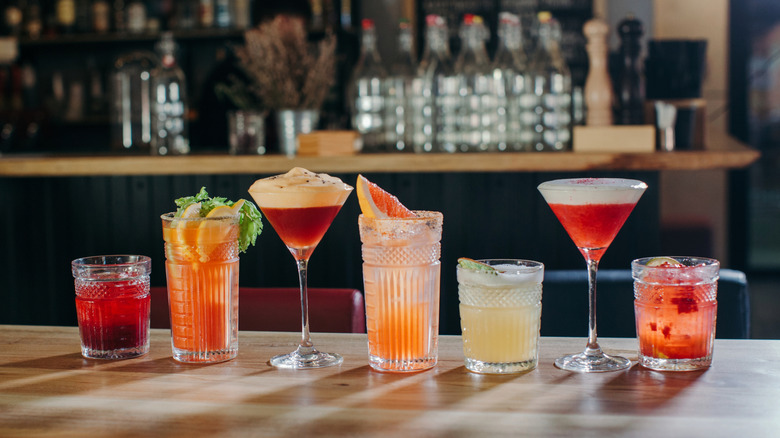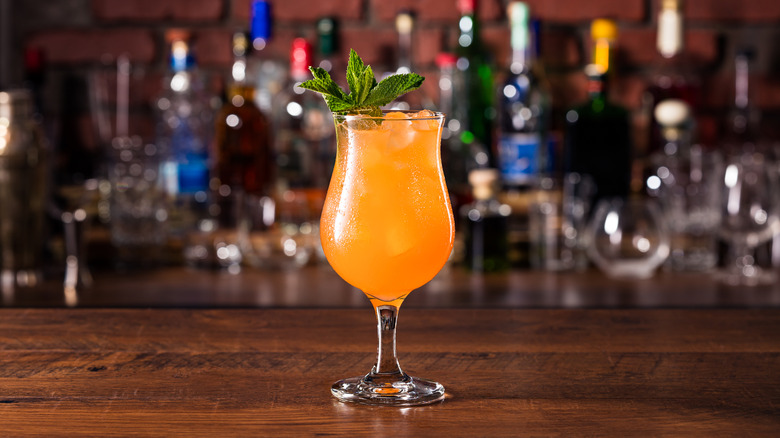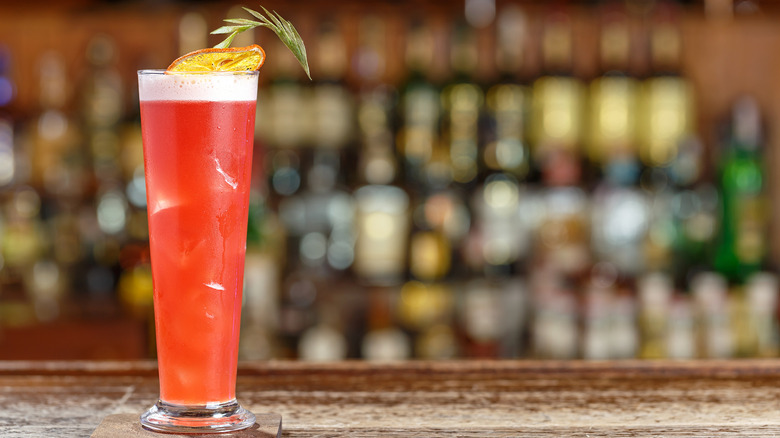11 Old School Cocktails From The '50s You Should Be Ordering
Cocktails have been mixed, shaken, and stirred to varying degrees for a long time, but they didn't become really popular until the 20th century. In the United States, this started in the 1920s for a sneaky, practical purpose at the height of Prohibition: mixing in juices, sweetener, or soda water took the edge off bootleg gin. The 1950s was comparatively a time of widespread economic prosperity in the US, which was also when the cocktail party became a trendy new way to host, socialize, and enjoy a greater variety of mixed drinks. Popularized through these social occasions, many cocktails — some new, some classic, some revived — became the preferred flavor profiles of the decade.
But a fair few of these '50s favorites got their start in watering holes all over the world. The majority of these favored combinations skewed towards cream-based or tropical, and many cocktails from the time emphasized rum or gin as a base. Some of these creations remain classics that you can still order almost anywhere, such as the Mai Tai or the piña colada. But there are many lesser known elixirs from the same era too, with names as decadent and whimsical as their lists of ingredients. From the velvety pink squirrel to the refreshing Singapore sling, here are 11 old school cocktails from the 1950s that you should definitely be ordering.
1. Pink squirrel
Popular lore suggests the pink squirrel's roots trace back to Bryant's Cocktail Lounge in 1940s Milwaukee, Wisconsin. Spiked with crème de cacao and the pink-tinged, almond-flavored crème de noyaux liqueur, this sweet and nutty combo originally got mixed with vanilla ice cream. The result was a boozy cocktail milkshake in a signature rosy shade. Such a creamy confection might have made sense in America's Dairyland, but it didn't catch on immediately elsewhere. In fact, the timing of these origins has also been called into question, as more lore talks about a publicity stunt in 1951. A crème de noyaux manufacturer hired an actress with a pink squirrel in tow to visit local bars asking for a cocktail of the same name, and nobody knew what she was talking about. The myth of the pink squirrel may have been its true origin tale, and the cocktail became a known drink after this stunt made the news, part of a larger trend of creamy cocktails that had a moment in the 1950s.
Always erring more on the dessert side, the pink squirrel has gotten a little less sweet in its subsequent reincarnations. Though the cocktail still retains its 3-ingredient simplicity, its two liqueurs typically get mixed with heavy cream in most places serving it up these days. Some recipes also switch out crème de menthe for the cacao of the original. Whatever the base, variations often top the whole thing with a dash of nutmeg.
2. Zombie
Another cocktail species that became wildly popular in the '50s was far removed from creamy and nutty flavor profiles that were conquering palettes at the time. This was also the era of tropical mixed drinks, part of a cultural tiki craze that surfaced in all aspects of postwar culture. Tiki bars were at their height in midcentury America, and concocted all kinds of tropical fruity confections that took the era by storm. This was the era of the Mai Tai and the piña colada, which still remain cocktail staples today. The zombie, however, is another '50s tiki drink that has fallen out of popularity, and certainly deserves a comeback.
Invented at a Hollywood bar around 1934, the zombie was mixed with clandestine ingredients and a lot of rum. So much rum, in fact, that bartenders were told to serve customers no more than two zombies each. These were a hit for packing a punch but also for the mystery of their true ingredients. Many bastardized versions began to grace cocktail menus by the time the '50s tiki craze had popularized tropical cocktails. Though the zombie's popularity eventually waned, its true ingredients have since come to light. Zombie cocktails are a perfect candidate for a revival from the dead, and have a reviving effect themselves. Common recipes mix many fruit juices and at least four rum varieties to achieve the proper effect.
3. Grasshopper
The grasshopper's origin tale starts somewhere just before Prohibition in New Orleans. Philibert Guichet, then the owner of Tujague Restaurant in the French Quarter, is said to be the creator of this bright green cocktail. Another sweet and creamy, three-ingredient confection, the grasshopper gets its name and signature green color from crème de menthe, which is mixed with crème de cacao and heavy cream for a thick, indulgent, equal parts chocolatey and minty dessert cocktail. While these origins are a bit hazy but not necessarily improbable, there is a suspicious lack of grasshopper evidence between the years of Prohibition and when the cocktail reached the height of its popularity in the 1950s and becoming a southern classic. The grasshopper's midcentury acclaim led to recipes for grasshopper pie, which borrows its name from the cocktail and pulls from the same creamy mint chocolate flavor profile.
A cousin of the cream-based pink squirrel, the grasshopper found success on Wisconsin menus in the 1950s too, and is another staple at Bryant's Cocktail Lounge, the same place credited with inventing the pink squirrel. The grasshopper was popularized as a dessert cocktail at the many supper clubs that gained traction in '50s Wisconsin. In fact, the Wisco take on the grasshopper is so embedded in the region that many have come to believe its true origin is in the midcentury Midwest. These grasshoppers are mixed with ice cream instead of heavy cream for more of a milkshake adjacent dessert cocktail.
4. Sloe gin fizz
Gin started to get popular in the 1920s, once improved distillation techniques led to a smoother taste. All this was supposedly for naught, however, once Prohibition banned the sale and production of alcohol across the United States. But gin was still consumed in vast quantities despite having become newly illegal — the bathtub variety was enjoyed throughout this era. "Bathtub gin" became a common title for homemade distillation operations which typically yielded a strong and unpalatable (but generally still drinkable) moonshine. Post-Prohibition, Depression, and WWII, gin finally had the opportunity to see the limelight once again as a mainstream spirit that could be served and enjoyed out in the open. Gin-based cocktails gained popularity in this postwar prosperity.
The 1950s saw more creative mixes than the classic gin and tonic, with cocktails like the Tom Collins and sloe gin fizz gaining popularity. The latter was a simple mix of soda water, sweetener, and lemon juice, an adaptation of the gin fizz, the only difference being that it contains sloe gin, a British spirit. Distilled with sloe berries, which grow plentifully in the UK but aren't very palatable on their own, sloe gin is unique for its ruby red color and a distinct tartness. This gin remained popular through the '50s, but lost notoriety in the following decades, as did the sloe gin fizz. But the cocktail has such a unique flavor profile with a refreshing twist that it is certainly deserving of a revival.
5. White Russian
Before the white Russian was the black Russian, a cocktail that really has no direct connection to Russia, as its origins trace back to 1949 Brussels, Belgium. There, a bartender dressed up some coffee liqueur, calling the mixture Russian in reference to the vodka that made up the other half of the cocktail. On the brink of the 1950s, it was perhaps inevitable that cream, one of the trending mixers of the time period, would get added to this coffee and vodka combo. But this particular drink remained a little more subtle than the other bonafide milkshakes popular at the time, which called for ice cream or heavy cream and lots of sweet liqueur. A simple splash of milk was all that was required as the final touch to transform this cocktail into what is now the white Russian.
Without the cream impulse that defined much of the mixology of the '50s, this cocktail might never have transformed into a trinity of ingredients that have withstood the test of time. Furthermore, the simplicity of the white Russian has perhaps led to its continued adaptability. The drink has seen more evolutions in the contemporary mixology scene, as the coffee liqueur in this cocktail has made it a prime candidate for baristas as well as bartenders. Experiments with coffee versus coffee liqueur have even begun to blur the distinction between a white Russian and an espresso martini.
6. Singapore sling
The Singapore sling was another contributor to the midcentury tiki craze that both paralleled and contrasted the rise in cream-based cocktails of the '50s. Rather than building a configuration around rum, which was the base for most tropical drinks of the era, the Singapore sling is gin-based, a unique attribute amongst other midcentury fruity cocktails invented to stir up visions of sultry climates. Though it existed decades before, the cocktail's use of gin mixed with tropical vibes positioned the Singapore sling to become a favorite in the '50s, embodying two aspects of mixology that were gaining traction at the time.
Invented in Singapore sometime before the 1920s, the Singapore sling was an adaptation of the sling itself, an early cocktail category that reached its height towards the end of the 19th century. Slings, at the time, were essentially the earlier way to describe a cocktail, as individually mixed drinks were then a new phenomenon in an era that still considered punch the predominant means of serving and consuming an alcoholic medley. Whatever ingredients the original recipe definitively contained – besides gin, sweetener, and lemon juice — remains unknown and up for debate, but variations of the drink have been served with all manner of enhancements, from additional spirits to more diverse fruit juices. But one particular version of the Singapore sling took off in the '50s through a standardized recipe in cocktail mixing guides: the addition of cherry brandy.
7. Golden Cadillac
First mixed together in 1952, the Golden Cadillac hails from El Dorado, California, with origins as mythic as the ancient golden city after which the NorCal town is named. This cocktail was allegedly a local bartender's response to a couple's request for something original. As the story goes, they'd just driven up in a new Cadillac, hence the inspiration behind the name. The Cadillac part of the story does at least seem to align with the time period in which this origin tale is set, as 1952 was also the year that the Cadillac Eldorado hit the market. Though intended to be more of a practical than luxury vehicle, this car was soon a coveted classic and became an emblematic icon of its era.
The Golden Cadillac cocktail's ingredients combine into a unique flavor profile that has become a different brand of classic. Typically made with the hint of anise and vanilla-flavored Galliano liqueur and white crème de cacao, the drink was another product of the '50s trend of creamy concoctions. Recipes call for half-and-half or heavy cream to mix everything into a luscious froth, with notes both herbal and chocolatey.
8. Blue Hawaii
Another tropical cocktail that took tastebuds by storm in the '50s was the blue Hawaii, definitively invented by Honolulu bartender Harry Yee in 1957. Yee's bar was popular with American servicemen stationed in Hawaii, and remained popular with them and other mainland visitors ever after. His signature drink was a feat of tropical deliciousness, with a mix including rum, vodka, coconut cream, pineapple juice, and blue curaçao. The result was a cocktail that came out in a shade of turquoise to rival the Pacific ocean.
The Blue Hawaii's instant popularity fed into the American fervor for island culture in the '50s, most prominent through the passionate consumption of tropical inspired cocktails. Hawaii — and anything associated with it — had a particular draw because many soldiers had come back from the South Pacific with eye-witness accounts of its landscape as a living paradise. While many tourists who ordered at Yee's bar chose the blue Hawaii with the idea that they were getting something local, the drink was just a further emphasis of the island life fantasy everybody wanted to live out. In fact, the inspiration behind the cocktail was merely a marketing push from a Dutch company that hoped to promote its blue curaçao. With an incongruous orange flavor that defied the color, the fantasy aspect of Yee's Blue Hawaii prompted the drink to become largely associated with vacations. Though it wasn't typically mixed outside of vacation mode, it certainly could be.
9. Brandy Alexander
The Brandy Alexander was a later spinoff of the OG Alexander, a cocktail invented in the early 1900s featuring gin, cream, and white crème de cacao. According to the most well-circulated origin tale, this combination was mixed together by a bartender called Alexander to create something snow white. It was a tribute to Phoebe Snow, a fictional character dressed all in white, who was invented as an advertising campaign to promote a new, soot-free form of train travel via locomotives that didn't run on coal. The drink evolved into many adaptations in the following decades, and first appeared in print in 1937 mixed with brandy instead of gin.
By the '50s, the brandy Alexander was a popular cocktail, yet another cream-based beverage served commonly as an after dinner treat. But by then, the drink was virtually unrecognizable from the original Alexander. Brandy eliminated the possibility for a snow white cocktail by giving the combination a light caramel color. The drink's popularity in the '50s, however, seems to have been more about the cream than the brandy. One popular recipe shared in a 1956 edition of the New York Times eliminated the hard liquor completely, suggesting that crème de cacao and iced coffee topped with whipped cream could still be called an Alexander, and made for a tasty dessert cocktail on a hot summer evening. Whether made with coffee, brandy, or both, a dash of nutmeg is a popular garnish, and the outcome is refreshing and tasty.
10. Vesper
While no one was really ordering this concoction before, the vesper martini was popularized in Ian Fleming's original James Bond novel, Casino Royale, first published in 1953. In the book, the protagonist orders this upscale martini, which is a mix of gin and vodka, dressed up with a splash of Kina Lillet and served with a twist of lemon. While this was certainly a configuration that was possible to produce in the 1950s, Vesper martinis can no longer be made exactly as Bond ordered them, since Kina Lillet no longer exists, due to a recipe change.
An aperitif wine hailing from Bordeaux, Kina Lillet contained quinine, which added a note of bitterness to the drink and anything it was mixed into. Bond's taste for such an acrid liquor may have been more to convey his worldly sophistication and macho taste than anything else. Though his preference for the drink inspired people to start ordering Vespers in the '50s, this was not enough to deter Kina Lillet from switching out its ingredients. Lillet, the French aperitif manufacturer of Kina Lillet, changed the recipe in the 1980s to formulate something that was more sweet than bitter, now called Lillet Blanc. This is why Vesper martini enthusiasts don't always recommend Lillet Blanc for contemporary revivals of this '50s cocktail. Purists' recipes suggest using Cocchi Americano instead, as this pungent Italian aperitif offers a more authentic kick of bitter à la James Bond.
11. Negroni
The Negroni, still a popular drink today, has Italian origins allegedly dating back to 1919. This was when Count Camillo Negroni, a regular at a bar on Tornabuoni Street in Florence, supposedly asked the bartender for something stronger than a typical Americano (Campari, vermouth, and soda water). The solution was to add a bit more kick by eliminating the soda water completely, and replacing it with gin. The result was an orange-tinged cocktail, bitter but refreshing. Thus, as the story goes, the Negroni was born.
While this is the most widespread origin tale, many have come to question who the Negroni behind the name really was. Some naysayers are in favor of a different story, that a General Pascal Oliver Comte de Negroni — who was French, not Italian — devised the Negroni as a stronger Americano in 1870, sometime during the Franco-Prussian war.
Surely the cocktail did exist in Europe prior to the 1950s, as director Orson Welles got a taste for the Negroni while shooting on location in Rome in 1947. But the earliest evidence of printed recipes for this drink doesn't appear until the '50s. The cocktail pops up in a handful of mixing guides of that era, reflecting a newfound popularity that may or may not have been connected to Orson Welles' publicized appreciation for the drink. Furthermore, variations on the Negroni can be mixed with many Campari alternatives, just one of many reasons it has remained a classic choice for cocktail enthusiasts ever since.











